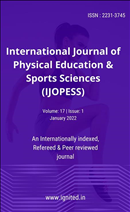Effects of Floor and Swiss Ball Exercise on the Rehabilitation of Back Pain
Main Article Content
Authors
Abstract
The purpose of the study was to find out the effect of floor and swiss ball exercise on therehabilitation of back pain. The researcher used the random group design in this study. In this researchdesign randomly selected sixty women who suffered from back pain. They were measured of their backpain through administration of Questionnaire and their initial back pain was determined. The subjectswere randomly divided into three groups, consisting of twenty subjects each. First experimental groupunderwent floor exercises prescribed for rehabilitation of back pain, the second experimental groupunderwent swiss ball exercises and the third group acted as control group. The experimental period wasfor five weeks. After the experimental period of five weeks, the subjects were tested of their back painlevel through administration of the questionnaire. The difference between the pre and post experimentalscores were considered the effect of the respective trainings given. The data collected were statisticallyanalysed through Analysis of Covariance (ANCOVA). The results shows that the obtained F value 20.23was greater than the required value of 3.15 and hence it was accepted that the floor exercises, and swissball exercises significantly reduced the back pain of the subjects compared to control group. Thepost hoc analysis of obtained ordered adjusted means proved that there was significant differencesexisted between swiss ball exercise group and control group and floor exercises group and controlgroup. And there was no significant difference between treatment groups, namely, floor exercises groupand swiss ball exercise group in altering back pain of the women. It was concluded that swiss ballexercises and floor exercises can be suggested for reducing back pain among women.
Downloads
Download data is not yet available.
Article Details
Section
Articles
References
- Baron R, Binder A, Attal N, Casale R, Dickenson AH, Treede RD (July 2016). "Neuropathic low back pain in clinical practice". European Journal of Pain. 20 (6): 861–73.
- Batt et al. (1996) “Athlete Rehabilitation and Reconditioning of Injured Athletes”, LNCPE Journal.
- Church E, Odle T. (2007) Diagnosis and treatment of back pain. Radiologic Technology serial online. 79(2):126–204
- Manchikanti L, Singh V, Datta S, Cohen SP, Hirsch JA (Jul–Aug 2009). "Comprehensive review of epidemiology, scope, and impact of spinal pain". Pain Physician. 12 (4): E35–70
- Marshall and Murphy (2006) “Multidimensional model to evaluate deficits in patients with low back pain (LBP)”,Journal of Strength and Conditioning Research 88 (3) 252-259
- Marshall P.W and Murphy B.A (2005) “Core stability exercises on and off a swiss ball”, Journal of Strength and Conditioning Research . 86 (2) pp. 242-249
- Patel ND, Broderick DF, Burns J, et al. (2009)ACR Appropriateness Criteria Low Back Pain. Available at https://acsearch.acr.org/docs/69483/Narrative/ (PDF). p. 6. American College of Radiology.
- Patel, A.T. and A.A. Ogle. (2008) "Diagnosis and Management of Acute Low Back Pain". Archived American Academy of Family Physicians
- Verbunt (2008) Reliability and validity of the physical activity decline (PAD), Archives on Physical Medicine Rehabilitation . 73 (10): 1376-79.
- Vezina, J.J. and Hubley-Kozey, C.L. (2000), “Muscle Activation in Therapeutic Exercises to Improve Trunk Stability”, Archives on Physical Medicine Rehabilitation Vol. 81 (10): PP. 1370-79.

